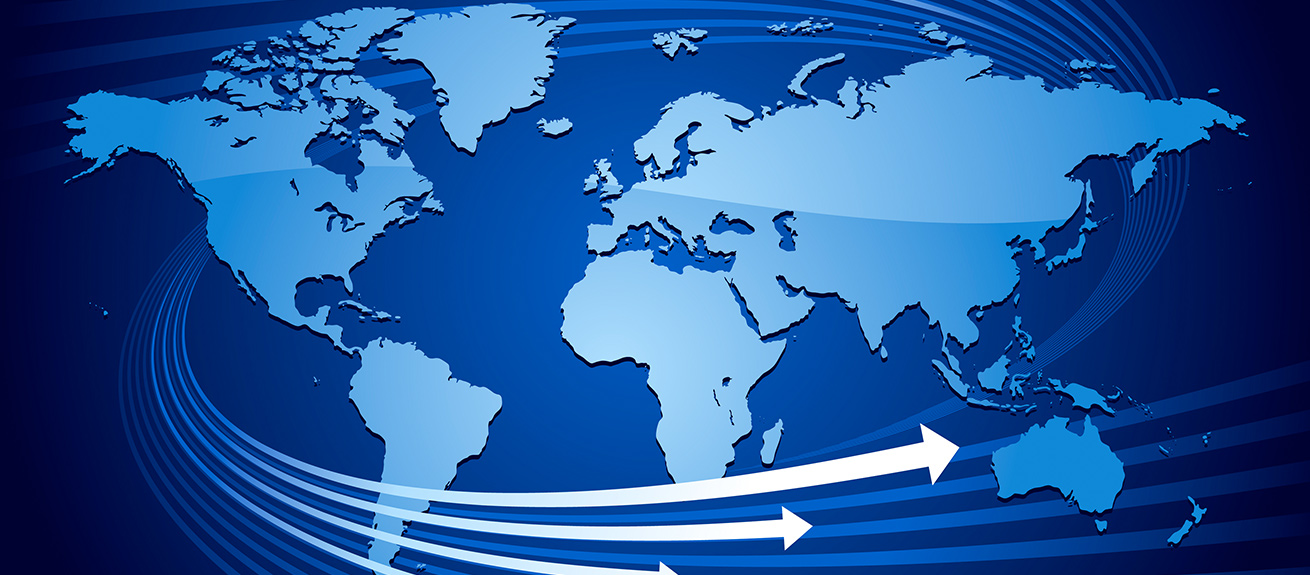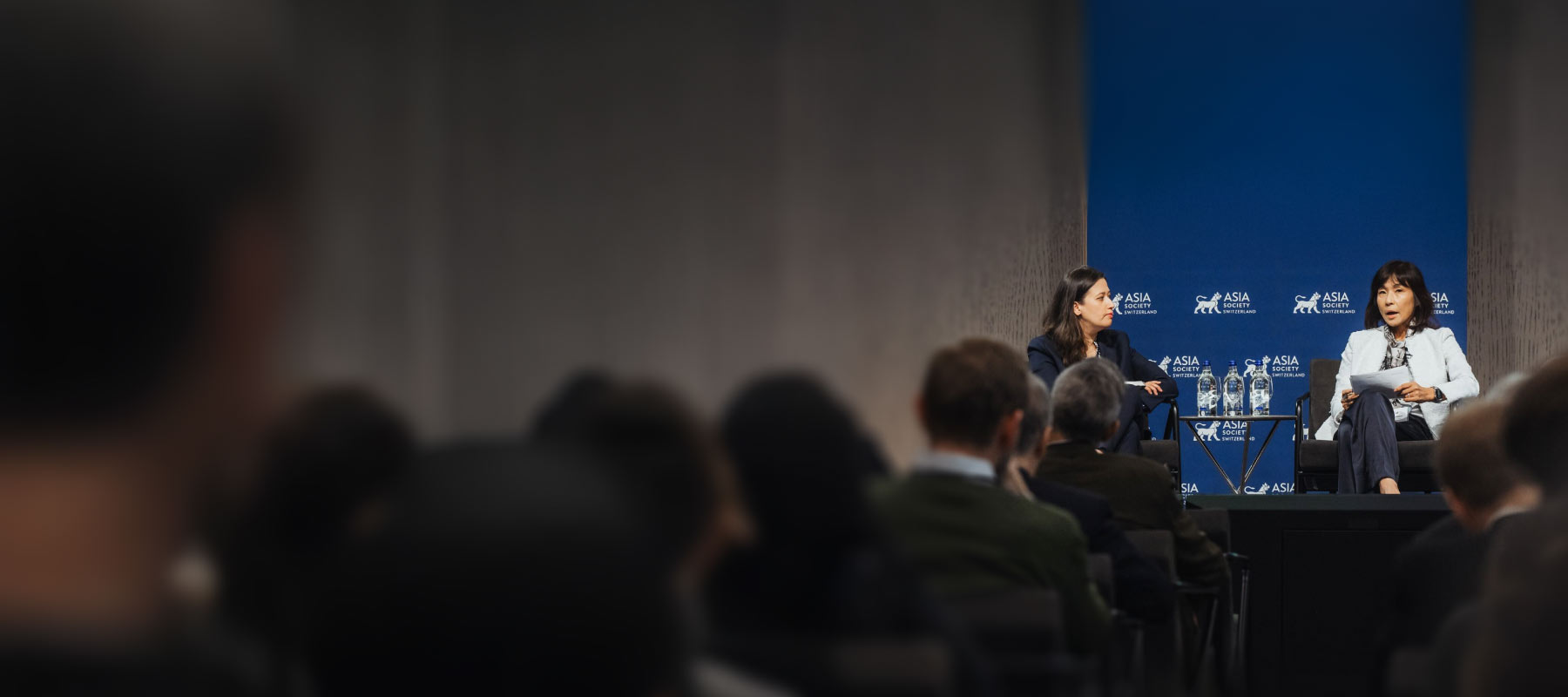About 70 executives, academics and representatives from governments and civil society attended a thought-provoking debate organized by The Evian Group@IMD. A panel of speakers, moderated by Professor Carlos Braga, looked at the future of globalization and questioned whether it is facing a real threat. The audience was also asked to rate the proposition that globalization is in trouble, both before and after the debate, and the findings were shared in real time.
The world economy has become increasingly interconnected and interdependent in the post-World War II era. Although the term “globalization” may mean different things to different people, it essentially conveys the idea of linkages among countries driven by international trade and services, with concurrent flows of capital, including foreign direct investment (FDI), technology, information and people – leading to increased integration of markets across political boundaries. Since the 2008 financial crisis, however, there are signs that the momentum of economic integration is stalling, trade liberalization seems to be losing its appeal as a major policy objective, and new regulatory initiatives have often adopted a protectionist bias that constrains the movement of goods, labor and capital. To begin the discussion on whether globalization is in trouble or not, Professor Carlos A. Primo Braga began by asking whether – for reasons that are politically motivated – we are going to see a situation similar to the 1930s when there was a significant roll-back of the process of economic integration and an increase in “beggar-thy-neighbor” types of policies. Could the process of international economic integration (i.e. globalization) be reversed?
Yes, globalization is in deep trouble!
Simon Evenett presented evidence drawn from five years of his research to raise the alarm about “hidden” protectionism. He stated, “Most protectionism is not easy to spot and is hard to monitor and count – that’s why it stays out of reports.” Since the onset of the global financial crisis, there have been instances of governments resorting to measures that tilt the playing field in favor of domestic commercial interests. Some of these actions do not fit the customary definition of protectionism, but nonetheless hurt the commercial interests of other countries. It was cause for concern in 2009, and G20 leaders committed to a halt on implementing new distortions to global commerce. There was a dip in 2010/11 as economies recovered, but thereafter, a sharp rise in protectionism occurred. The scenario is even more serious when viewed after correcting for reporting lags – the data (red line) reveal a steep increase in protectionism measures in 2012, reaching levels much worse than 2009. Based on these findings, he stressed, “If governments were worried then, they should be even more worried now!”
Professor Evenett explained that in 2009/10 most of the protectionist measures were taken by industrialized countries, but since then large emerging countries have been catching up. This protectionism took place despite the WTO’s global architecture of trade rules and the spread of regional trade agreements. He highlighted three key reasons for the WTO’s ineffectiveness in stopping these practices:
The types of “beggar-thy-neighbor” policies have changed, so they are not being caught by WTO’s standard safety net. Instead of tariffs and quotas, the “new” protectionism has taken the form of trade-distorting subsidies, government contracts and access to credit on easier terms, tax breaks, financing deals with strings attached, local content requirements for multinational companies (MNCs) going to foreign countries, and bailouts.
The way the WTO measures protectionism often relies on “inaccurate data” that focuses on the wrong trade barriers. Such data reveals only the tip of the iceberg of global protectionism, while the bulk remains hidden under the surface, as revealed in reports from the Global Trade Alert (GTA) think-tank. Consequently, the WTO does not see the big picture of the extent to which global trade is being affected.
WTO rules, centered as they are on tariffs and more transparent trade policies, are incomplete and weak. Just as the types of global commerce have multiplied, so have the means available to governments to disadvantage foreign firms, thus helping nations to circumvent WTO rules.
These points are consistent with Professor Evenett’s reality check with MNCs which noted that their biggest concern is corporate political risk – encountering all sorts of unanticipated policy risks on the ground in the many countries in which they operate. For example, the European Commission is investigating some major international firms for tax avoidance, while the British government voiced concerns over US Pfizer’s bid to buy AstraZeneca. He concluded, “Termites are eating away at globalization. There are many ways to frustrate globalization and distort competition – it is not just about raising trade barriers and tariffs – and we are seeing a lot of it now!”
No, globalization will continue to move forward!
With his deep experience in negotiating trade agreements, Alejandro Jara took an optimistic view. While he agreed that the financial crisis had seen the introduction of some protectionist measures, such as anti-dumping duties, producer subsidies and buy-local provisions, he argued that these policies were largely piecemeal and ad hoc. They did not result in a significant closing of markets and the world did not retreat into isolationism – in fact, it has struggled to move forward toward liberalization. World trade rebounded in 2010 and has been growing steadily but slowly, ever since. Furthermore, he stressed that technology, a key driver of globalization, would certainly continue to move forward, not backward. It is difficult, if not impossible, to reverse it.
Because of greater interdependence, local measures increasingly impact other economies (through a technical standard or a subsidy), or even have a global impact (carbon emissions). Thus, there is a need for better global governance or cooperation, usually achieved through international treaties, MOUs, actions by international or regional agencies, and a myriad of soft and hard laws. Better governance is necessary to harness globalization and ensure that people are able to benefit from reforms. Has global governance been up to the challenge? Certainly not! Many countries have dysfunctional political systems that impede an effective and timely response. At the multilateral level (for climate change issues, IMF governance, the Doha round) it is the same. Political leadership has been lacking, except at the beginning of the financial crisis when the G-20 played an active role.
A bigger role for corporations is envisaged by coming together, for example during World Economic Forum meetings, to give a country-specific scorecard highlighting the metrics of poor performance, which will serve to hold governments accountable. Governments would hate to be exposed in this way!
Mr Jara acknowledged that some paradoxes exist in global trade. On the one hand, the rate of growth has slowed due, in part, to changes in global value chain mechanisms, which are susceptible to policy disruptions; changes in FDI patterns and even non-economic considerations. On the other hand, there is greater unilateral liberalization, brought to the fore by countries such as China, Mexico and Canada. In addition, there are the “outlier” countries – Brazil, India, Argentina and South Africa – which have been unable to forge important preferential trade agreements. Another paradox is seen in the contrast between the lesser degree of traditional protectionism due to WTO commitments and bilateral agreements, and the higher degree of other kinds of protectionism because of trade remedies (local content, investment discrimination and so on). In view of the above, the picture of globalization is, in many respects, incomplete because the Doha Development Agenda (DDA) has not concluded and new issues such as investment are not covered. Mr Jara believes that rebalancing will take place, driven by factors such as:
- The economics of competitiveness, as governments continue to be pushed by the private sector to embark on trade liberalization.
- Resistance to peer discrimination, as countries hate to be discriminated against in the global market. Therefore, it is in their interest to push for multilateral agreements.
- Geopolitics, whereby countries want to be in a leadership position as “rule makers,” not “rule takers.”
The virtuous cycle of global value chains, FDI, services and the impact on SMEs.
In summing up, he asserted, “Things will move in the right direction even though it may be bumpy and possibly take time. We need better global governance, institutions, accountability and rules but we will get there.”
Now for something completely different – the Asian perspective
Professor Jean-Pierre Lehmann looked at the challenge of globalization from the Asian perspective. He contended that viewing globalization as a win-win does not necessarily correspond to reality. First, the historical dynamics of globalization are too often forgotten. During the 19th and 20th centuries, in the era of European expansionism, Asia was exploited and impoverished. By 1950, its share of global gross domestic product (GDP) had dropped to less than 20%, from 60% in 1820. Now, with the gradual shift of the economic balance toward the East, 21st century globalization is being driven by the Asian narrative. He pointed out that the West had played without rules on the basis of strength and power, yet in the current era of globalization, standards are being developed without full participation of emerging economies and this trend is not sustainable.
Asia encompasses a vast territory, stretching from the Red Sea to the East China Sea, along with tremendous diversity in religion, culture, politics and economic development. There is no doubt that certain regions – specifically China and India – are having increasing impact and hence will have major roles to play. The world is also witnessing the “Asianization of Asia” as more and more Asian countries are either looking at one another or – more specifically – at China with regard to socio-economic progress and investments in energy, trade and infrastructure. For example, the new Silk Road Economic Belt across the Eurasian continent proposed by Chinese President Xi Jinping is seen to have huge potential, especially as a strategic base of energy resources in the new millennium.
So far, the current wave of globalization has been good for Asia, resulting in poverty reduction and positive social and economic change. But geopolitics forms a prominent part of the equation, as evidenced by the fragility that exists in countries such as Thailand and Burma. Moreover, the region remains a cauldron of territorial disputes, with China at the vortex. Japan has a fair number of current and historical issues with China, including a tense dispute over the Senkaku/Diaoyu Islands. Similar hostilities exist with Vietnam and the Philippines in the South China Sea, in addition to ongoing disputes with Brunei and Malaysia. China also controls part of India’s water supply, with upstream rivers flowing through Tibet, and several incidences of Chinese incursions along the 3,500-km-long border have strained relationships. Despite all these issues, China remains the lead trade partner of all Asian countries with a significant export-import gap skewed in its favor. Tensions are further aggravated by the lack of strong regional institutions governing trade and security.
Professor Lehmann then turned the focus to the global arena, in which China – armed with lots of cash – is making significant investments, funding US debt, rescuing failing European firms, and has concluded a 30-year natural gas deal with Russia. Against this backdrop, the US and EU, though forces to be reckoned with in the WTO, are no longer able to impose their will. It seems almost impossible to envisage one power rising and the other declining without clashing as they pass each other; the actions of Beijing and Washington suggest an escalating rivalry. China perceives the US’s so-called pivot to Asia – via intrusive and divisive mega-regional trade agreements such as the Trans-Pacific Partnership (TPP), as well as alliances with Japan, South Korea and Australia – as part of a concerted strategy of containment aimed at preventing China’s re-emergence. The question that arises next is: Can the US and China, whose economy is estimated soon to overtake the US, learn to live together in the 21st century?
Being a global merchandise exporter with huge investments throughout the world, China’s position is, however, vulnerable. In addition, food security is a critical concern as the country has 21% of the global population but only 7% of the world’s arable land. China has to rise above its domestic challenges and construct a leadership role to be able to secure its future. Professor Lehmann argued that there is an urgent need for a new global architecture and an imperative to strengthen inclusive global rules and institutions. But as things stand in mid-2014, and with the failure of the WTO member countries to finalize the Doha Round, it is not at all clear what this new architecture might look like and at what levels constructive partnerships will occur. “What guarantees are there, that during this era of rising economic rivalry, globalization in its current form will survive?” he asked.
And the debate goes on…
During the discussion participants raised several far-reaching questions that the panelists tried to answer in the time available. They touched on the aim of globalization, the leadership role of China, the need for governments to be more accountable, how corporations can modify their role to add value, new kinds of disruption brought about by technology, with seen or unseen backlashes – topics for future Evian Group@IMD debates. Professor Braga closed the event by drawing the focus closer to home, comparing the political and economic dimensions of globalization in Europe. Clearly, people in Europe increasingly have mixed feelings about the benefits of globalization, which were perhaps exaggerated and not properly conveyed at the outset. The overall perception is that globalization is an elitist project. The swing to the far right in recent European Parliament elections is an expression of people’s discontent over the free movement of people across borders and perceptions that it contributes to unemployment of locals, including rising youth unemployment. These concerns are magnified by the relative ineffectiveness of training interventions in the labor market, the loss of national identity and problems of leadership. These recent political developments are a warning signal that emphasizes the need to better understand the root causes of dissatisfaction and to better manage the necessary economic and social adjustments that are part and parcel of the process of globalization.


